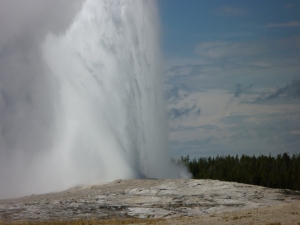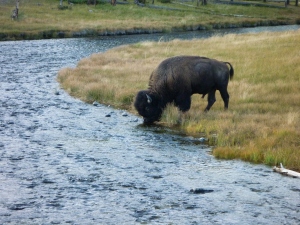Yellowstone National Park was the first national park in the country. For decades, tourists have come from everywhere in the world (I’ve heard more foreign languages here, though many are European or east Asian) to see what has been called ‘The Greatest Show On Earth’ by tour promoters. Yellowstone is kind of the park of all parks, so I’m glad I’ve had the opportunity to see some of it. Much of the park is actually a caldera of an old volcano, and geothermal features provide the greatest draw of all the attractions. Yellowstone apparently has the largest collection of these in the world, and even though every site I visited swarmed with tourists, they are undeniably fun to see. Geysers, hot springs, big boiling lakes, thermophile bacteria mats looking like the mold that grows on your old, half-eaten tub of yogurt, roaring steam vents, and bubbling mud pots cluster in areas of the park with long, twisting boardwalks winding through them. At the entrance of each boardwalk is a large, hilarious sign with drawing of a kid, face contorted in pain, falling through the ground: Do not leave the path! Dozens have been scalded to death! The ground is a thin crust and easily breaks! There is definitely a subdued quality to the gurgling springs and geysers, fenced as they are by the boardwalks and warning signs, but for all that they’ve been civilized, it is exciting to see, hear, and smell evidence of the very active world under our feet.
Another draw to the park is wildlife. Bears, moose, elk, and bison are favorites it seems, as cars slow and crowd roadways, and cameras emerge like strange robotic faces from windows at every sighting. I have to say, it’s fun to see bears from a crushing throng of steel-framed automobiles and excitable humans rather than around a blind corner in a thick berry patch in the middle of nowhere and all alone. The elk are nice, and deer are always lovely. But especially thrilling are the bison, large and prehistoric looking with huge, bulging, unblinking, and unperturbable eyes. I’ve seen them walking, eating, drinking, only feet away from the car window, their lovely, scrunchable woolly heads dragging over the ground under all the great weight of their massive… brains? fur? eyeballs?, and propelled by their funny-looking, naked legs. Bison move ponderously slow, looking like big, mossy brown rocks in an ambling roll across the meadows.
I met my partner, who lives in Seattle, here several days ago, and lo and behold I’ve become a vehicle-constrained tourist. I have enjoyed every last minute of it, sitting in the car watching the rain roll right off the windshield as we effortlessly whiz up hills and through gusts of wind. We’ve gone through much of the park, taken some day hikes, seen the iconic attractions, and kicked around West Yellowstone. I’ve had a much needed rest from the bike, and during some rather foul weather which makes it all the more delicious to sit in a coffee shop over a steaming cup of tea. I have, for contrast, the car-tourist experience in the middle of the world’s premier car-tourist destination. Very few people leave the roads in Yellowstone, and the whole park is set up so that one may explore it’s most well-known and exciting features without hardly leaving the comfort of the vehicle. And the truth about Yellowstone is that much of that park isn’t all that extraordinary. For astonishing natural beauty, Glacier National Park has Yellowstone easily beat, as does much of Washington State. Even some of the National Forests, those unloved stepchildren of the protected wildlands, along this ride have been more beautiful. But the wildlife and the geothermal features of the park make it a singular place worth visiting, not to mention it’s history.
The history is what gets me. Dan and I toured the museum in West Yellowstone, where we were treated to some great exhibits about the crazy crazy and occasionally asinine manner of visitors to the park. Fairly quickly after it’s inception, hotels sprang up all over the park so that the wealthy could take a week-long stage coach tour of the park without too much discomfort. The ‘dudes’, as the wealthy visitors of the park were referred to, would throw objects into the hot pools, feed the bears, pet the bison, and generally assumed that a national park wasn’t all that different from Central Park: it’s existence was purely for the pleasure of the visitor. It was common entertainment to watch bears feeding on garbage dumps, and rangers would clean the hot pools and find large quantities of junk – nails, hair pins, coins, handkerchiefs (this last item was especially common in the so-called Handkerchief Pool, which was a famous stop on the tour of the park where the wealthy visitors would toss in their handkerchiefs only to have them spit out again in a few minutes by the currents, cleaned and ready for use). There were even officially designated bear feeding areas of the park until as recently as the 1970s. It almost seems like a century ago, people were most interested in seeing a dominated and docile natural world: Old Faithful was lit up like a city fountain by spotlights from the adjacent lodge, where visitors were serenaded by string quartets as they rocked in their rocking chairs and ogled the display. The park now is more hip to the fact that all these intrusions can have negative effects on the ecosystem of the park: visitors face steep fines for throwing things into the pools, for example, and feeding the bears is generally discouraged. Moreover, there seems to have been a change in how tourists wish to view the park, perhaps a resutl of the very modern and efficient world most of us now inhabit. The ethos with which most approach the park is now one of caution and of a desire to see the natural world as unpredictable, a little dangerous, and wild. We thrill at the hint of nature when we see bison shuffling across the road, but most stay in the safety of the their vehicles.
Also interesting is the regrowth of the park after the 1988 fires, which burned roughly half of the park acreage (some 1.3 million acres, I think). The forest was a late-stage Lodge Pole pine forest, which are almost built to burn anyway to clear the way for new growth. But the fire was intense and left many with the mistaken impression that Yellowstone had irreparably burned to cinder piles on the ground. In truth, it is in early stages of regeneration, though it has a post-clearcut quality, especially in the burnt areas.
Over all, it’s been nourishing to rest, to see a loved one, to shower to my heart’s content. Yellowstone has been an interesting experience, both to see the park and learn it’s history, and to spend some time being that car tourist that has occasionally annoyed me so greatly over the last month. I’m ready to ride again, though I’m also ready for some nice, balmy weather. In any case, the road beckons.









3 comments
Comments feed for this article
September 9, 2010 at 8:26 pm
Dan F
Thank you for a lovely time in Yellowstone, which I can now forget, since this post has captured it so well. Seeing the bison was a mindblowing experience, especially when they meandered so close. But better was getting to be by your side as we explored the park together.
It’s hard to leave, but I know you have plenty of adventures awaiting you on the road. I’ll look forward to reading about them here.
September 10, 2010 at 7:56 pm
Diederik
Hi Katharina!
What a beautiful pictures have you! You didn’t told me you where a photographer! Nice story about Yellowstone. I think you wil be on the Road now again? Me to but i go to jenny lake in Grand Teton to hike three days and then i will return to the great devide again. Hope i will see you there again! I will call you, if that is somewhere possible in Wyoming. Not sure about that:p
Greetings
Diederik (Diedrich :))
September 15, 2010 at 1:37 pm
sue fischer
Hi dear, It looks like you are having a great adventure. I am glad Dan came to be with you for awhile.The weather here has been very fallish and beautiful. I just went to Utah to learn fly fishing… I have skills now!
Oneward Ho!